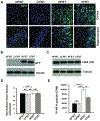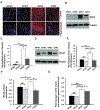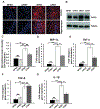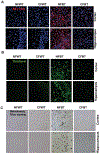Curcumin Ameliorates Neuroinflammation, Neurodegeneration, and Memory Deficits in p25 Transgenic Mouse Model that Bears Hallmarks of Alzheimer's Disease
- PMID: 29036814
- PMCID: PMC8092919
- DOI: 10.3233/JAD-170093
Curcumin Ameliorates Neuroinflammation, Neurodegeneration, and Memory Deficits in p25 Transgenic Mouse Model that Bears Hallmarks of Alzheimer's Disease
Abstract
Several studies have indicated that neuroinflammation is indeed associated with neurodegenerative disease pathology. However, failures of recent clinical trials of anti-inflammatory agents in neurodegenerative disorders have emphasized the need to better understand the complexity of the neuroinflammatory process in order to unravel its link with neurodegeneration. Deregulation of Cyclin-dependent kinase 5 (Cdk5) activity by production of its hyperactivator p25 is involved in the formation of tau and amyloid pathology reminiscent of Alzheimer's disease (AD). Recent studies show an association between p25/Cdk5 hyperactivation and robust neuroinflammation. In addition, we recently reported the novel link between the p25/Cdk5 hyperactivation-induced inflammatory responses and neurodegenerative changes using a transgenic mouse that overexpresses p25 (p25Tg). In this study, we aimed to understand the effects of early intervention with a potent natural anti-inflammatory agent, curcumin, on p25-mediated neuroinflammation and the progression of neurodegeneration in p25Tg mice. The results from this study showed that curcumin effectively counteracted the p25-mediated glial activation and pro-inflammatory chemokines/cytokines production in p25Tg mice. Moreover, this curcumin-mediated suppression of neuroinflammation reduced the progression of p25-induced tau/amyloid pathology and in turn ameliorated the p25-induced cognitive impairments. It is widely acknowledged that to treat AD, one must target the early-stage of pathological changes to protect neurons from irreversible damage. In line with this, our results demonstrated that early intervention of inflammation could reduce the progression of AD-like pathological outcomes. Moreover, our data provide a rationale for the potential use of curcuminoids in the treatment of inflammation associated neurodegenerative diseases.
Keywords: Amyloid; Cdk5; curcumin; neurodegeneration; neuroinflammation; p25; tau.
Figures






Similar articles
-
Cdk5/p25-induced cytosolic PLA2-mediated lysophosphatidylcholine production regulates neuroinflammation and triggers neurodegeneration.J Neurosci. 2012 Jan 18;32(3):1020-34. doi: 10.1523/JNEUROSCI.5177-11.2012. J Neurosci. 2012. PMID: 22262900 Free PMC article.
-
SLOH, a carbazole-based fluorophore, mitigates neuropathology and behavioral impairment in the triple-transgenic mouse model of Alzheimer's disease.Neuropharmacology. 2018 Mar 15;131:351-363. doi: 10.1016/j.neuropharm.2018.01.003. Epub 2018 Jan 5. Neuropharmacology. 2018. PMID: 29309769
-
Cdk5 Inhibitory Peptide Prevents Loss of Neurons and Alleviates Behavioral Changes in p25 Transgenic Mice.J Alzheimers Dis. 2020;74(4):1231-1242. doi: 10.3233/JAD-191098. J Alzheimers Dis. 2020. PMID: 32144987
-
Involvement of inflammation in Alzheimer's disease pathogenesis and therapeutic potential of anti-inflammatory agents.Arch Pharm Res. 2015 Dec;38(12):2106-19. doi: 10.1007/s12272-015-0648-x. Epub 2015 Aug 21. Arch Pharm Res. 2015. PMID: 26289122 Review.
-
Neuroprotective and Neurological/Cognitive Enhancement Effects of Curcumin after Brain Ischemia Injury with Alzheimer's Disease Phenotype.Int J Mol Sci. 2018 Dec 12;19(12):4002. doi: 10.3390/ijms19124002. Int J Mol Sci. 2018. PMID: 30545070 Free PMC article. Review.
Cited by
-
Pathogenesis of Alzheimer's disease and therapeutic strategies involving traditional Chinese medicine.RSC Med Chem. 2024 Oct 3. doi: 10.1039/d4md00660g. Online ahead of print. RSC Med Chem. 2024. PMID: 39430949 Free PMC article. Review.
-
Inflammation, Autoimmunity and Neurodegenerative Diseases, Therapeutics and Beyond.Curr Neuropharmacol. 2024;22(6):1080-1109. doi: 10.2174/1570159X22666231017141636. Curr Neuropharmacol. 2024. PMID: 37898823
-
Combination of epigallocatechin 3 gallate and curcumin improves D-galactose and normal-aging associated memory impairment in mice.Sci Rep. 2023 Aug 4;13(1):12681. doi: 10.1038/s41598-023-39919-4. Sci Rep. 2023. PMID: 37542120 Free PMC article.
-
Biomaterials-based anti-inflammatory treatment strategies for Alzheimer's disease.Neural Regen Res. 2024 Jan;19(1):100-115. doi: 10.4103/1673-5374.374137. Neural Regen Res. 2024. PMID: 37488851 Free PMC article. Review.
-
Phytochemicals as Substances that Affect Astrogliosis and their Implications for the Management of Neurodegenerative Diseases.Curr Med Chem. 2024;31(34):5550-5566. doi: 10.2174/0929867330666230504121523. Curr Med Chem. 2024. PMID: 37143267 Review.
References
-
- Nikolic M, Chou MM, Lu W, Mayer BJ, Tsai LH (1998) The p35/Cdk5 kinase is a neuron-specific Rac effector that inhibits Pak1 activity. Nature 395, 194–198. - PubMed
-
- Smith DS, Greer PL, Tsai LH (2001) Cdk5 on the brain. Cell Growth Differ 12, 277–283. - PubMed
-
- Kusakawa G, Saito T, Onuki R, Ishiguro K, Kishimoto T, Hisanaga S (2000) Calpain-dependent proteolytic cleavage of the p35 cyclin-dependent kinase 5 activator to p25. J Biol Chem 275, 17166–17172. - PubMed
-
- Lee MS, Kwon YT, Li M, Peng J, Friedlander RM, Tsai LH (2000) Neurotoxicity induces cleavage of p35 to p25 by calpain. Nature 405, 360–364. - PubMed
-
- Patrick GN, Zukerberg L, Nikolic M, de la Monte S, Dikkes P, Tsai LH (1999) Conversion of p35 to p25 deregulates Cdk5 activity and promotes neurodegeneration. Nature 402, 615–622. - PubMed
MeSH terms
Substances
Grants and funding
LinkOut - more resources
Full Text Sources
Other Literature Sources
Medical

